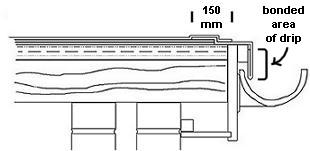Eaves refers to the lowest part of the roof often located in the vicinity of the guttering where the roof overhangs the property.
Roofing felt into gutter.
In the past traditional roofers felt was used at the eaves level however nowadays a more modern rigid protection system can be specified.
The only time you need felt or drip trays going into your gutters is if the tiles don t allow the rain water to go straight in to your gutters and run behind your fascia into your soffit a lot of people just say you need them so they can rip people off and do it anyway.
Just hook the bracket under the front lip of the gutter and then screw the other side of the bracket to the fascia.
Trapped behind the guttering or if it is badly weathered it needs to be replaced.
If this felt is either incorrectly situated i e.
One way to make sure your gutter doesn t fall off the house is to install fascia hanger brackets.
The bottom course of felt on a roof called sarking felt ensures that all of the rainwater is correctly channeled into the gutter by protecting the eaves from any wind driven rain.
This involves stripping back the last few courses of tile or slates to remove the old felt and re fix the new.
This type of drip edge is not the best choice to use when you.
It works great with gutters and is the most affordable.
Eaves felt can best be described as the roofing felt that overlaps into the guttering.
Some roofing felts are actually glued down.
Type d drip edge is an older style of drip edge that is not commonly used today and may be found on older homes.
These applications are ideal for flat roofs or protective surfaces under roof level decks.
Installing the roofing felt does take care but can go very quickly.
The felt running into the guttering is always the first bit of felt to wear because it is exposed to all the elements it allows the water to run into your gutter and away from the roof if missing it can cause the facia boards to rot and cause dampness.
This is a great choice for any standard roofing project like a home or a shed.
These thick layers of roofing felt are installed by heating the back of the felt with a butane torch and then carefully applying it to the roof.

